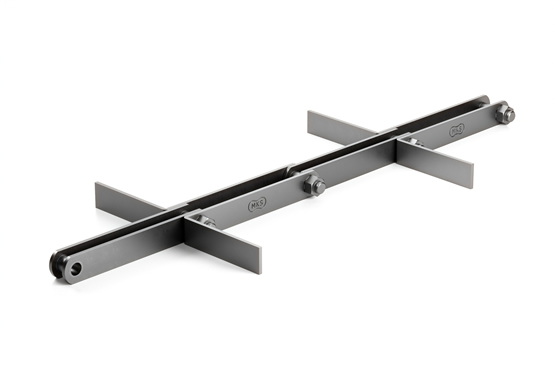
What Is a Conveyor Chain?
Conveyor chains are used to transport loads and bulk goods. At Makelsan Chain, we proudly offer an extensive selection of conveyor chains, each engineered for specific applications. The industrial world demands non-standard chains, which is why we specialize in crafting conveyor chains tailored to your unique requirements. Fixed bush conveyor chains are often used for conveying tasks involving long distances and relatively low speeds. Rotary Api chains for heavy-duty applications feature crank links for greater flexibility and improved cushioning against heavy impacts.
Our product range is remarkably versatile. It encompasses bucket conveyor chains, roller chain conveyors, hollow pin chains, scraper chains, specialized conveyor chains, and rotary chains designed for the paper industry. We also offer conveyor chains with various custom attachments, whether straight, curved, or U-shaped, and much more.
FV series ( DIN 8165 ) scraper chains, M series ( DIN 8167 ) scraper chains, Rotary chains, long pitch FVT and MT series chains are conveyor chains in our production in different varieties. Types of chain conveyors include apron, drag, plain chain, scraper, flight, and en-masse conveyors.
How Does a Conveyor Chain Work?
The conveyor chain functions in a two-sided system with a pulley system, which is an important external component. For smooth operation, this system helps a belt move on a frame. Generally, each unit has two rotors, but more complex systems can include more.
The drive wheel supports the chain and rotates to apply force to the chain. The force comes from friction and also the load’s weight. The chain is supported by idler wheels too. They can be smooth/toothed and also rest on plates/rollers. A slack part of the chain gives extra support.
The chain itself has bearings linked by plates, which feature a brush and pin for roller revolving around. When it is activated, the motor rotates the chain an then it moves the material on it. This shows the synergy of mechanical components in industrial applications.
What Are the Features of a Conveyor Chain?
Conveyor chains are significant industrial components in various industrial applications, designed for efficiency and reliability in material handling. Here are the key features of chain conveyor systems:
- Durable: Made up of bearings for robustness and smooth roller movement.
- Adjustable Complexity: Basic systems have fewer rotors, while more complex ones have extra rotors.
- Motor-Driven System: It rotates the chain when the motor turns on, which moves materials efficiently.
- Pulley System Compatibility: It works with a pulley system for steady material handling.
- Drive Wheel: The rotating wheel applies force to the chain by friction and the load weight.
- Idler Wheels: Can be smooth/toothed, supporting the chain, or resting on plates/rollers.
- Chain Tension Support: Provides additional power to keep chain tension.
- Versatile Application: Suitable for different industrial applications, such as conveying or feeding materials.
What Are the Advantages of a Conveyor Chain?
Conveyor chains are an essential component in industrial material handling, which offers a high range of benefits. Here are the conveyor chain advantages:
- Conveyor chains are designed to handle heavy loads, making them suitable for harsh industrial applications. Also, they offer flexibility for different industrial needs.
- They can be used in forklift applications, allowing for easy loadings on the conveyor systems.
- Damaged rollers within the conveyor chain system can easily go under maintenance.
- Despite their heavy-duty power, conveyor chains may be customized with powered turntables for versatile material handling.
- Conveyor chains are specifically designed to handle the palletized goods movement.
These advantages show the effectiveness and adaptability of conveyor chains in different industrial handling processes.
In Which Fields Are Conveyor Chains Used?
Conveyor chains are used in a wide range of areas due to their efficiency in material handling. Here are some of the key industries:
- Manufacturing
- Mining and Heavy Industry
- Agriculture
- Automotive Industry
- Recycling Plants
- Food and Beverage Processing
- Warehousing and Distribution
- Pharmaceuticals
- Airport Baggage Handling
- Retail
The adaptability of conveyor chains to different areas and their power to handle a range of materials make them a good component in many other industries.
What Factors Should Be Considered When Choosing a Conveyor Chain?
When choosing the right conveyor chain for your industrial needs, many significant factors should be considered to ensure optimal performance:
- Load Capacity: It’s important to choose the weight the conveyor chain should support. Lightweight chains can handle lighter loads while heavier loads need heavy-duty chains.
- Length and Connection Methods: The chain length must match the needed transportation distance.
- Environmental Conditions: The operational environment influences the chain selection, such as temperature, humidity, and chemical exposure,
- Speed Capacity: For high speeds or frequent cycling, chains with higher strength and sealing capabilities should be selected.
- Cost: Conveyor chain prices can change according to materials and specifications. It’s important to balance cost with environmental factors to make a well-informed choice.
In short, when selecting a conveyor chain, deciding your needs in terms of load capacity, environmental conditions, operational speed, chain length and connection methods, and cost is important.
Scraper conveyors are high-performance conveying machines for the horizontal and ascending transport of very different materials.
A scraper conveyor is a material transportation device utilizing a continuous, driven chain circuit equipped with regularly spaced cross members. The chain travels through an channel or trough which prevents the transported materials from falling off the conveyor while the cross members drag or “scrape” them forward to the discharge point. Scraper conveyors are typically used for coarse, heavy materials such as raw coal, iron ore, cast metal parts, and metal scrap. The design is ideal for slower transportation speeds over short distances, on moderate inclines, or even in submerged applications. This type of conveyor is typically more cost effective to install and maintain than a belt conveyor of similar capacity and length.
Chain conveyors use an endless chain both to transmit power and to propel material through a trough, either pushed directly by the chain or by attachments to the chain. The chain runs over sprockets at either end of the trough. … The load is positioned on the chains, the friction pulls the load forward.
The primary purpose of the scraper is to prevent material carry back on the conveyor system. By reducing material carry back, the conveyors can run more efficiently by having fewer breakdowns and lower running costs. Efficient and correctly adjusted scrapers save the plant operator time and money.



